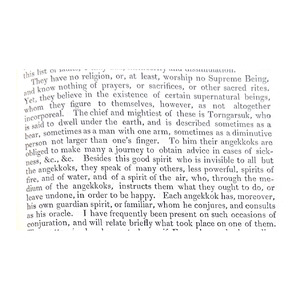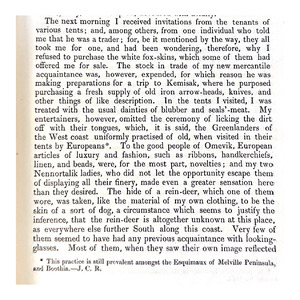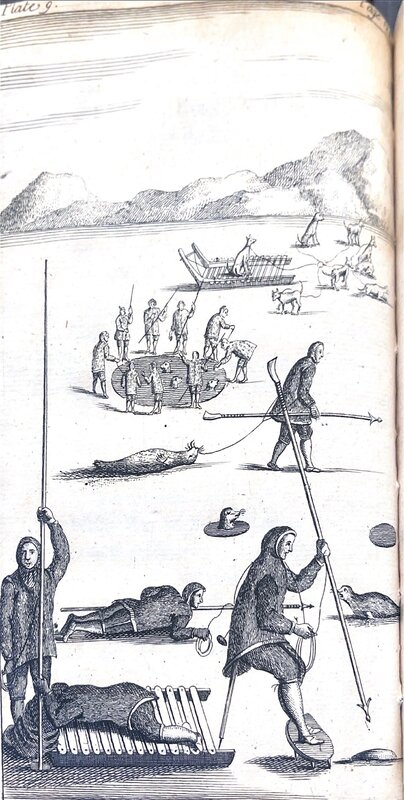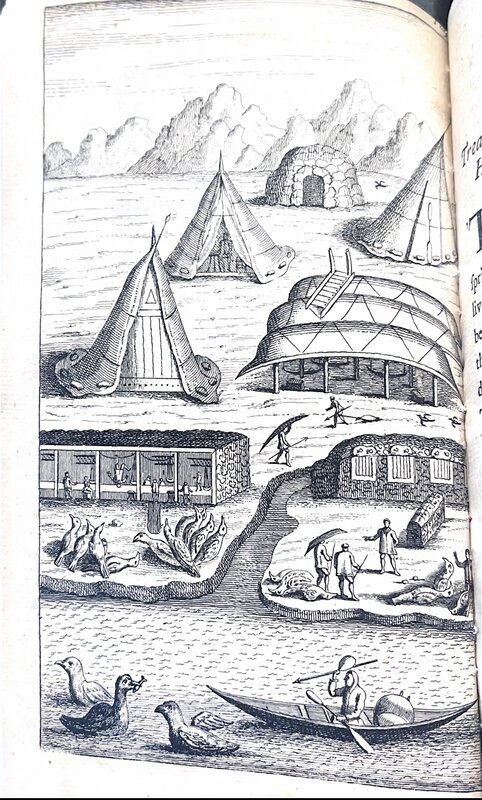Indigenous Interactions and Ways of Life
Beliefs: In this excerpt, Captain Graah struggles to comprehend the spiritual beliefs of the indigenous Angekkok people of Greenland from his standpoint as a European Christian. He expresses that they have no religion in his view because they do not worship a singular Supreme Being. He observed that they worshipped many spirits that are connected to the land, unseen by any except the Angekkoks themselves. He goes on to explain how their beliefs play out in daily life to the health of individuals and the procurement of their food. This exposure to a new system of beliefs shows the European travelers that others believe in things different than God or a singular entity. In this description such differences are not met with hostility, just surprise and curious observations.
Trade: In the words of Captain W. A. Graah of the Danish Royal Navy while in search of the lost colonies encountered a native tribe in Greenland, the Omerikkans. The piece notes the interaction between Captain Graah and the Omerikkans and how the novelties of European life like handkerchiefs and ribbons were introduced and exchanged for seal meat and blubber. This was where trade was introduced to the Omerikkans, showing them what goods come from the European continent. The women of Nennortalik, another tribe the voyage interacted with, flaunted their European jewelry and fine clothes while visiting Omevik. The idea of luxury goods that could serve a non-utilitarian purpose began to permeate.
Occupations: The most common indigenous pursuits observed by European explorers were fishing and hunting. On land, they would often hunt for reindeer and birds. On the sea, they would fish and hunt sea fowl and whales. They would use bows and arrows made from fir trees and string made from the muscles of animals. The arrows were made of animal bones or iron, allowing them to kill from large distances with few arrows. The Arctic indigenous peoples also engaged in traditional hunting practices that were novel for Europeans. For example, whale hunting expeditions were generally about half men and half women. there was no discrimination for who was on the hunting party. The women would carry large nets, as well as needles and thread to mend patch clothing onto holes in their boats so they would not sink. Meanwhile, the men would search for whales, and strike them with harpoons with seal skin air-bag-like pockets that would keep the whales afloat, preventing them from submerging. After the whales got exhausted, the men would dive into the water, and cut the fat of the whale's belly. Another example is how they would cut holes in the ice above seal pods, and strike them with harpoons.
Living: Their houses were built with stone and turf, around three yards high, with flat roofs. The windows were all on one side of the house, made of seal bowels that were sown together. The other side of the houses had beds on shelves. The bedding was made of seal and reindeer hide. Several families (up to around 8) would live together, each family occupying a room with wooden poles that kept the roof up. The houses also had fireplaces, where families would cook and dry their clothes.
Inter-Village Relations: Though there is no formal government in Greenland, villages are anything but lawless. Each member of the village is raised to have a good nature, and keen to treat other members with respect. When European explorers came to Greenland, they notes in their journals how "one cannot admire how peaceable, lovingly, and united they live together." You will never find hatred or envy between them, much less a grudge. They do not steal from each other, so there is no system of stealing from each other, yet according to the journals, they may steal from outsiders as they see themselves as the true inhibitors of the land, so they have the right to take small things from the explorers. However, they are very hospitable to visitors. They take them into their homes with open arms, and provide food to them.
While the Occupations, Living, and Inter-Village relations were displayed from an educational perspective, trying to only inform, the same journals that provided us this knowledge also displays the sense of superiority from the explorers. This is especially seen when describing their temperaments and their cultural lifestyles. In The Natural History of Greenland, the Greenlandic indigenous groups are described as having phlegmatic temperament, which leads to their "cold nature and stupidity." The author continues by saying that their want of education contributed the most to their coldness and stupidity. Later in the journal, we see more of this as their manners and common day to day way of life is viewed as nasty and filthy, claiming that the way the bathe is similar to how cats clean themselves by licking their paws. The explorers complained that the Greenlandics smell is insufferable, and the way they eat is just as "nasty."




